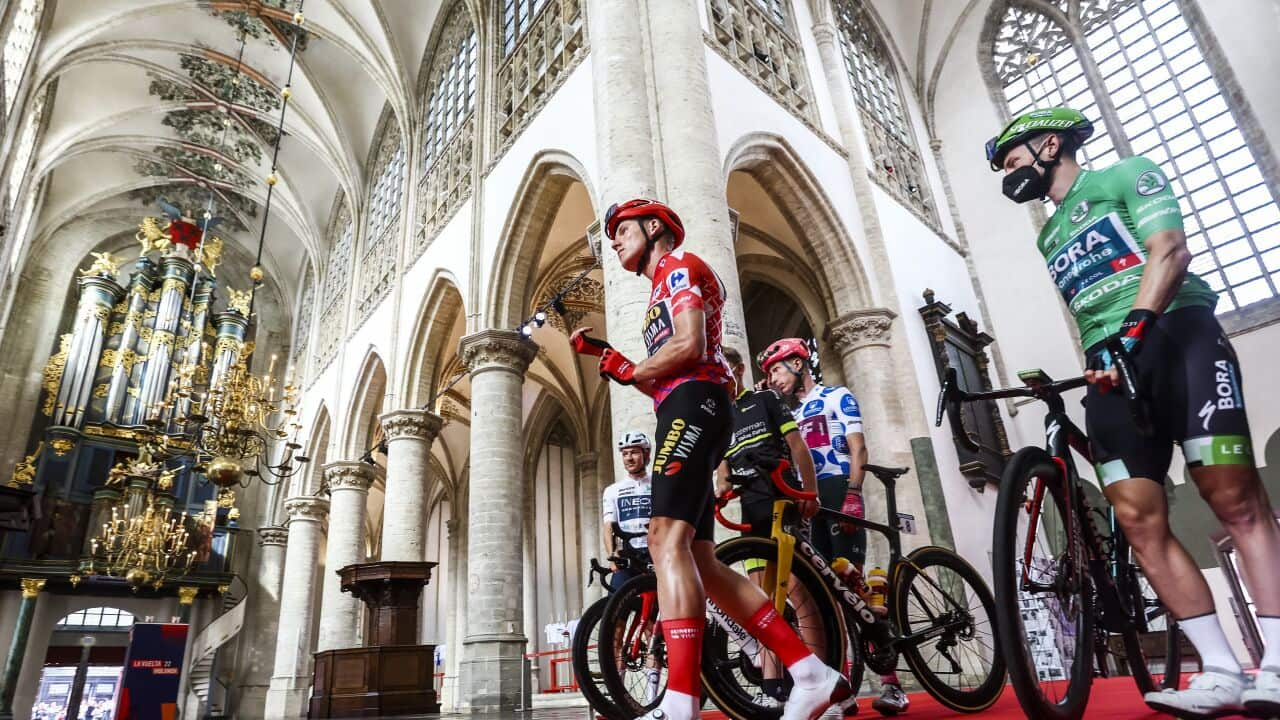BORA-hansgrohe maximising new-age leadout
La Vuelta hasn’t offered up the smoothest of sprint stages to date. There’s not one or two dominant teams, for instance. But the washing machine effect of the peloton surging and positioning in the final few kilometres has crystallized a few things, at least in my head, for contemporary sprinting.
One, it’s really hard to take the front of the race for more than a kilometre. So many teams are trying to be up at the pointy end that you burn through riders really quickly trying to maintain position. It’s far from the days of the '90s and '00s when one or two teams would sit on the front of the race for the final 10 kilometres.
Last night’s stage was a good example, there were five or so teams that took over leadership at the head of the peloton in the final two kilometres and perhaps the best tactical decision of the stage came with an intentional decision to give up the lead.
Ryan Mullen was on the front of the race with 800 metres to go, but rather than contributing, he immediately swung off as he was aware that Sam Bennett was further back. Too many leadout riders simply put their head down and ride as hard as possible. If Mullen had done that it likely would have taken the race through to 400 metres to go, where Juan Sebastian Molano (UAE Team Emirates) could have then done a proper last man leadout for Pascal Ackermann. Instead, Molano was pressed simply to keep the pace up to prevent Ackermann being swamped and the German had to launch with 300 metres to go.
That enabled Danny van Poppel’s acceleration from seventh wheel to bring Sam Bennett into the battle, with the Irish sprinter strong enough to finish it off.
Groves not seeing bountiful harvest at Vuelta
The other thing that has been apparent from the early stages is that positioning is very much a balance of team strength, teamwork and a sprinter’s ability to fight for position. Young Australian sprinter Kaden Groves and BikeExchange-Jayco have only rarely managed to find that combination throughout the first few years of his career.
Last night’s stage was another example of Groves not really getting a chance to showcase his sprint. He was brought towards the front with 1.5 kilometres remaining, but got bumped off the wheel of his train by Intermarche’s Gerben Thijssen, and then had to subsequently fight his way forward for the rest of the race without support.
He was 23rd through the crucial corner at one kilometre to go and it was essentially race over. It was impressive to recover to finish seventh in the end.
Groves climbs better than almost all sprinters not called Wout van Aert and Mathieu van der Poel, and without those two at the Vuelta, he may have some more opportunities to sprint from reduced pelotons, which could see these positioning problems lessened.
The Jumbo-Visma Jersey shuffle
It’s a nice sight to see a team reward the riders who put in the hard work to get them to the top, and that’s what Jumbo-Visma have been doing since taking the race lead on the opening stage team time trial.
From two Dutch riders sharing the jersey in Robert Gesink and Mike Teunissen, it’s now over to Italian Edoardo Affini, a team workhorse who spends a lot more time on the front of the peloton than the top of a podium. Teunissen was an impressive fourth on Stage 2, but he gave up his Stage 3 chances to drop down and finish 150th, which allowed Affini to take over the lead.
Next in line is likely to be Sam Oomen, if it doesn’t end up being hard enough at the Stage 4 finish that Primož Roglič ends up taking a time gap along with other explosive climbers to the rest of the peloton.
Traffic furniture and dummy spits
Dutch roads through urban areas are famously great for commuters and other cyclists mixing with cars, but the infrastructure that separates riders from heavy vehicles is difficult to navigate for a 180-rider strong peloton at racing speed.
Alejandro Valverde, riding in the final Grand Tour of his storied career, was fuming after the stage.
“We’ve had a lot of scares in general,” said Valverde, “because, well, the route… better first I have a shower, then we can talk, because if I say what I think now… better I say nothing.”
When pressed by reporters, Valverde continued, pointing towards the design of the course by organisers that takes the race through the towns to attract tourism dollars from local and provincial governments.
“These kinds of routes just can’t be,” said Valverde. “It’s as if we’ve gone through the same village seven times. I don’t think there were any more villages out there that we could have gone through.”
He wasn’t the worst off, Richard Carapaz (INEOS Grenadiers) went down with 21 kilometres to go through a roundabout, but recovered to rejoin the peloton. The Ecuadorian star shrugged off reporter questions after the stage, and said that he wasn’t hurt, so should still be in shape to contest the general classification.
The same can’t be said for Michael Woods (Israel-Premier Tech), who crashed, admittedly, on a straight section of road. Woods is out of the Vuelta now as he rests up after sustaining a concussion.
Dutch Vuelta fans nearly match Danish Tour de France hype
The overwhelming scenes from the Tour de France's Grand Depart from Denmark were really impressive but the Dutch fans have come close to matching their fervour in the opening three days of the Vuelta a Espana. Massive crowds, people waving flags, beaming faces in good weather and towns rolling out the red carpet…literally.
The riders dismounted and walked their bikes through the Great Church in Breda, a welcome departure from the normal humdrum neutralised sections that accomplish little. This at least gave viewers some new sights and organisers (presumably) some tourism dollars.


